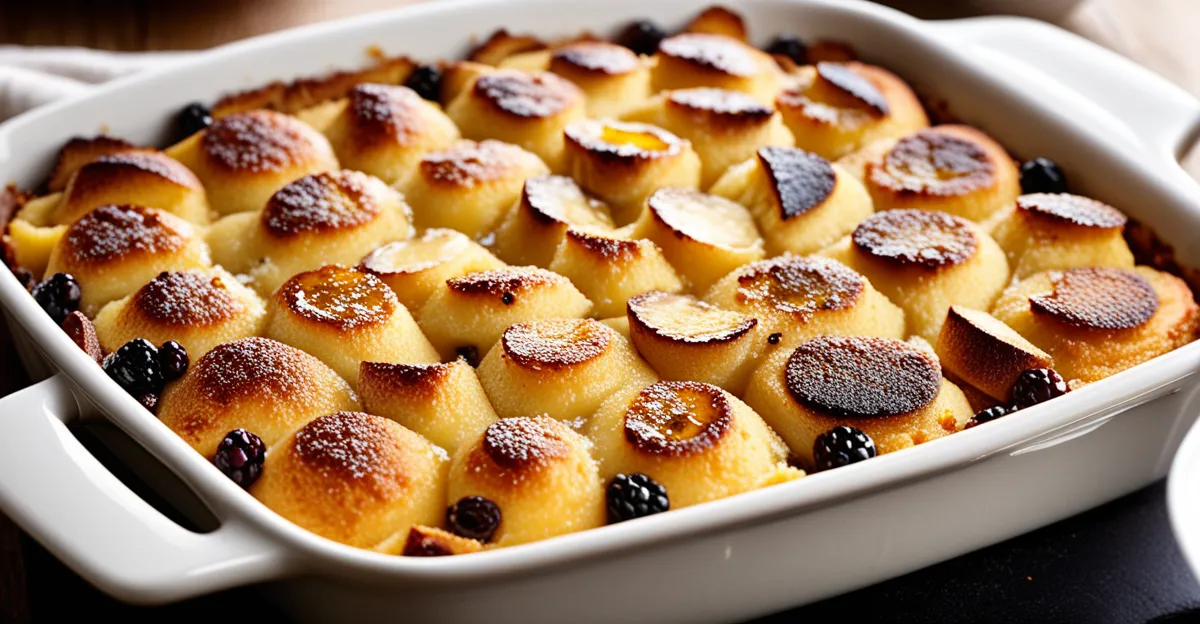Essential Ingredients for Creamy Bread and Butter Pudding
Achieving a creamy bread pudding starts with selecting the right bread choice. Enriched breads like brioche or challah are ideal because their tender crumb soaks up custard beautifully without becoming mushy. These breads have a higher fat content which enhances the pudding’s richness and texture.
Next, the dairy selection profoundly impacts creaminess. Using full-fat milk combined with double cream provides the perfect fat balance to create a luxurious mouthfeel. The freshness of eggs is equally important since they set the custard, binding the pudding while maintaining softness. Fresh eggs help avoid any off flavors and ensure a smooth texture.
Also to read : How do you prepare a classic full English breakfast at home?
Flavor additions are subtle but elevate creaminess significantly. Vanilla, nutmeg, and citrus zest each contribute aromatic layers that complement the pudding’s buttery base. Incorporating these elements into the custard or directly onto the bread before soaking enhances both taste and creaminess.
In summary, the synergy between enriched bread, premium dairy selection, fresh eggs, and well-chosen flavorings lays a robust foundation for a creamy bread pudding everyone will enjoy. This careful ingredient selection ensures that every bite is rich, tender, and full of flavor.
Also to discover : What are the variations of the classic toad in the hole recipe?
Preparing and Layering the Bread
Proper bread layering is crucial for a rich pudding that achieves maximum custard absorption. Begin by slicing the chosen bread—ideally brioche or challah—into even pieces about 1.5 to 2 cm thick. This thickness strikes the right balance: thin enough for custard to soak through but thick enough to maintain structure during baking.
Next, generously butter each slice. Butter acts as a flavor enhancer and forms a barrier that helps the surface crisp slightly while allowing the interior to remain soft. When arranging the bread in the dish, avoid overlapping excessively. Instead, layer slices so the custard can access most surfaces for deeper infusion.
To increase custard absorption, gently press the bread down after each layer to maximize contact with the custard once poured. This technique ensures the creaminess bread pudding develops uniformly.
Incorporating add-ins like raisins, chocolate chips, or dollops of marmalade between layers further enriches texture and flavour. Scatter these inclusions evenly to prevent clumping, which can disrupt the even custard soak and resulting creamy texture.
Efficient bread layering and technique result in a pudding that’s indulgently smooth and evenly rich throughout every bite.
Crafting a Rich Custard Base
The custard ratios in bread and butter pudding are fundamental to achieving that elusive creamy texture. A well-balanced egg to dairy proportion typically sits around one large egg per 125ml of combined full-fat milk and double cream. This ratio ensures the custard sets firmly yet remains silky and soft. Too many eggs lead to a rubbery texture, while too few result in a loose, runny pudding.
Whisking technique also plays a pivotal role in the pudding mixture. Beat eggs gently before incorporating warmed milk and cream gradually, which helps avoid curdling and produces a smooth, lump-free custard. Adding sugar to the mix should be done judiciously—excessive sweetness can destabilize the custard’s delicate proteins, causing unintended separation.
For enhanced flavor, infuse the dairy with vanilla pods, a pinch of nutmeg, or citrus zest before combining with eggs. This layering of aromas integrates seamlessly with the custard’s texture, enriching the overall creaminess. Mastering the custard base sets the stage for a luscious, tender bread and butter pudding that melts delightfully on the palate.
Soaking and Assembly Methods
Mastering pudding soaking is key to achieving a luxuriously creamy texture. For maximum custard infusion, soak the layered bread for at least 30 minutes before baking. This allows the custard to penetrate fully, saturating the bread without making it soggy. Soaking too briefly results in a dry center, while too long may cause the bread to break down excessively.
During soaking, covering the dish with cling film or foil helps retain moisture and encourages even custard absorption. However, uncovering the pudding for the last 10 minutes before baking promotes a slightly crisp top, creating pleasant textural contrast.
Resting the assembled pudding for 10 to 15 minutes before baking also enhances creaminess. This pause lets the custard settle uniformly throughout the bread layers, preventing uneven cooking and ensuring the custard sets to a delicate silkiness.
In summary, appropriate soaking time combined with covering techniques and a brief resting period form the foundation for a sumptuous, creaminess bread pudding. These steps guarantee that the custard infuses deeply and bakes evenly, producing an indulgently smooth result admired in expertly made bread and butter pudding.
Baking Techniques for Creamy Results
Achieving a creamy bread and butter pudding hinges on precise baking temperatures and methods that safeguard custard texture. Baking low and slow, around 150–160°C (300–320°F), ensures gentle heat penetration, allowing the custard to set evenly without curdling or drying out. High oven temperatures risk overcooking the eggs, causing a rubbery, cracked surface rather than a silky custard.
Using a bain-marie (water bath) is a highly effective technique for maintaining stable heat. The water surrounding the baking dish moderates oven temperature fluctuations, reducing the risk of custard overcooking. It also promotes a glossy, smooth surface and prevents edge drying, a common issue when baking directly on a hot oven rack.
To judge the pudding’s doneness, look for subtle visual cues: the custard should be just set with a slight wobble at the center. Avoid waiting until firmness throughout—the residual heat will complete the setting. Underbaking leads to runny custard, while overbaking dries it out.
By mastering these baking techniques, you ensure your pudding delivers maximum creaminess and a tender, luscious finish every time.
Troubleshooting Common Problems
Dry pudding often results from baking at too high a temperature or using too many eggs, which causes the custard to set too firmly. To prevent dry pudding, ensure you bake low and slow, maintaining temperatures around 150–160°C. If your pudding turns rubbery, it may be overcooked or contain excess eggs. Balancing the egg to dairy proportion carefully is critical; too many eggs tighten the custard excessively.
Curdled custard usually happens when eggs are added to hot milk too quickly or the mixture is overheated. To fix curdled custard, strain the custard as soon as possible and bake it gently using a bain-marie to moderate the heat. Whisking eggs gently before slowly incorporating warmed milk and cream can prevent curdling from the start.
If the pudding is too runny, it might have insufficient eggs or too much liquid. Increase egg content slightly or reduce milk and cream. Conversely, a too-firm texture indicates overbaking or excess eggs.
Addressing these texture troubleshooting tips ensures your creaminess bread pudding stays tender, silky, and perfectly set. Careful temperature control and proper custard balance are key to avoiding common pitfalls.






